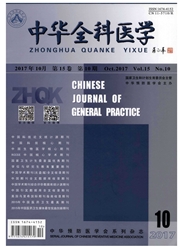

 中文摘要:
中文摘要:
目的 分析乌鲁木齐腹泻婴幼儿轮状病毒(Rotavirus,RV)感染流行情况及其基因型特征。方法 将2007年1-12月收集于乌鲁木齐市第一人民医院(儿童医院)的3 662例5岁以下门诊和住院腹泻患儿粪便标本,采用胶体金法和ELISA法检测RV,并随机选取部分RV阳性样本进行G/P基因分型。结果 3 662例样本中检出RV阳性1 470例,检出率为40.1%。对其中142例阳性样本(约10%)进行RV PCR基因分型,其中121例婴幼儿阳性分型结果显示:G1型比例最高占36.4%,其次为G3型(20.7%)、G2型(15.7%)和G9型(13.2%),G型混合感染占6.6%,G未能分型9例(7.4%)。P型分型以P[8]为主,占60.3%,其次为P[4](18.2%)和P[6](5.8%),P混合感染占15.7%。最主要的G/P组合为G1P[8](28.1%,34/121),其次是G3P[8](19.8%,24/121)、G2P[4](14.9%,18/121)和G9P[8](8.3%,10/121),并检测到不常见组合基因型如G1P[6]、G1P[4]、G9P[4]和G9P[6]等。21例新生儿(≤28 d)阳性样本的分型结果为:G型以G9为主,占42.9%(9例),其次是G1(4例),G3(3例),G2(1例),G混合感染3例,未能分型1例。P型以P[6]为主,占47.6%(10例),其次是P[8]及Pmixed各5例,P[4]1例。G/P基因型组合以G9P[6]为主(6例),其次G1P[8]、G3P[8]和G1P[6]各2例,G2P[4]和G9P[8]各1例。结论 本年度轮状病毒流行基因型复杂多样。婴幼儿RV感染以G1P[8]为主,新生儿RV感染则以G9P[6]为主。需警惕婴幼儿RV株与新生儿RV株的交叉混合感染而致新流行株的产生。
 英文摘要:
英文摘要:
Objective To analyze the epidemiology and genotype characteristics of group A rotavirus in children under 5years old with diarrhea in Urumqi. Methods During the year of 2007,a total of 3 662 diarrhea stool samples were collected from outpatients and children hospitalized under the age of 5 in the First People's Hospital of Urumqi. RV antigens were detected by colloidal gold assay and ELISA. About 10% RV positive samples were randomly selected for G / P genotyping. Results RV was detected in 1 470 of 3 662 samples( 40. 1%) and a total of 142 positive samples were typed by PCR. Of the 121 infants and children with RV infection,G1 accounted for 36. 4%,followed by G3( 20. 7%),G2( 15. 7%) and G9( 13. 2%),the G mixed infection was 6. 6% and 9 couldn't be typed. For P-type,P[8]was the predominant genotype with 60. 3%,followed by P[4]( 18. 2%),and P[6]( 5. 8%). P mixed was 15. 7%. The major G / P combination was G1P[8]( 28. 1%),next for G3P[8]( 19. 8%),G2P[4]( 14. 9%) and G9P[8 ]( 8. 3%). G1P[6 ],G1P[4],G9P[4] and G9P[6] were also detected as the G / P uncommon combinations. 21 neonates with RV diarrhea showed G9 was the major G genotype( 9 /21),followed by G1( 4 /21),G3( 3 /21) and G2( 1 /21). G mixed infections were3 and 1 was undetermined. P[6] ranked first with 10,P[8] and P mixed were 5,respectively. One was P[4]. G9P[6]was found to be the major G / P type in neonates. G1P[8],G3P[8] and G1P[6] were detected for 2 each and G2P[4],G9P[8] for one each in neonates. Conclusion RV genotypes were complex and diverse in 2007 in Urumqi. G1P[8]was the main G / P combination in infants and children,and G9P[6]was the main in neonates. It needs to be mindful that the mixed infection between infant RV strains and neonatal RV strains will produce new epidemic strain.
 同期刊论文项目
同期刊论文项目
 同项目期刊论文
同项目期刊论文
 期刊信息
期刊信息
